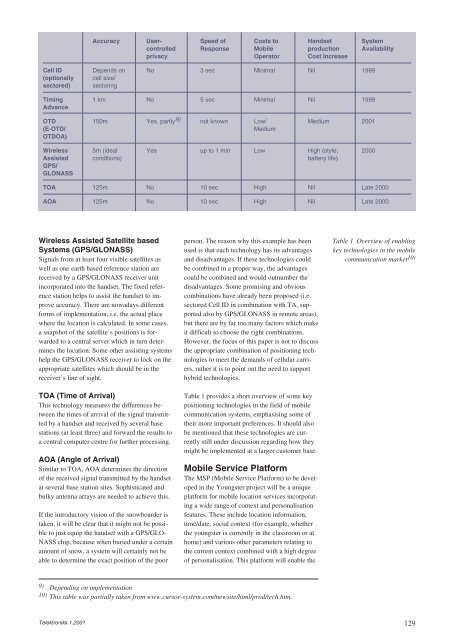You also want an ePaper? Increase the reach of your titles
YUMPU automatically turns print PDFs into web optimized ePapers that Google loves.
Telektronikk 1.2001<br />
Accuracy User- Speed of Costs to Handset System<br />
controlled Response Mobile production Availability<br />
privacy Operator Cost Increase<br />
Cell ID Depends on No 3 sec Minimal Nil 1999<br />
(optionally cell size/<br />
sectored) sectoring<br />
Timing 1 km No 5 sec Minimal Nil 1999<br />
Advance<br />
OTD 150m Yes, partly 9) not known Low/ Medium 2001<br />
(E-OTD/ Medium<br />
OTDOA)<br />
<strong>Wireless</strong> 5m (ideal Yes up to 1 min Low High (style, 2000<br />
Assisted conditions) battery life)<br />
GPS/<br />
GLONASS<br />
TOA 125m No 10 sec High Nil Late 2000<br />
AOA 125m No 10 sec High Nil Late 2000<br />
<strong>Wireless</strong> Assisted Satellite based<br />
Systems (GPS/GLONASS)<br />
Signals from at least four visible satellites as<br />
well as one earth based reference station are<br />
received by a GPS/GLONASS receiver unit<br />
incorporated into the handset. The fixed reference<br />
station helps to assist the handset to improve<br />
accuracy. There are nowadays different<br />
forms of implementation, i.e. the actual place<br />
where the location is calculated. In some cases,<br />
a snapshot of the satellite’s positions is forwarded<br />
to a central server which in turn determines<br />
the location. Some other assisting systems<br />
help the GPS/GLONASS receiver to lock on the<br />
appropriate satellites which should be in the<br />
receiver’s line of sight.<br />
TOA (Time of Arrival)<br />
This technology measures the differences between<br />
the times of arrival of the signal transmitted<br />
by a handset and received by several base<br />
stations (at least three) and forward the results to<br />
a central computer centre for further processing.<br />
AOA (Angle of Arrival)<br />
Similar to TOA, AOA determines the direction<br />
of the received signal transmitted by the handset<br />
at several base station sites. Sophisticated and<br />
bulky antenna arrays are needed to achieve this.<br />
If the introductory vision of the snowboarder is<br />
taken, it will be clear that it might not be possible<br />
to just equip the handset with a GPS/GLO-<br />
NASS chip, because when buried under a certain<br />
amount of snow, a system will certainly not be<br />
able to determine the exact position of the poor<br />
person. The reason why this example has been<br />
used is that each technology has its advantages<br />
and disadvantages. If these technologies could<br />
be combined in a proper way, the advantages<br />
could be combined and would outnumber the<br />
disadvantages. Some promising and obvious<br />
combinations have already been proposed (i.e.<br />
sectored Cell ID in combination with TA, supported<br />
also by GPS/GLONASS in remote areas),<br />
but there are by far too many factors which make<br />
it difficult to choose the right combinations.<br />
However, the focus of this paper is not to discuss<br />
the appropriate combination of positioning technologies<br />
to meet the demands of cellular carriers,<br />
rather it is to point out the need to support<br />
hybrid technologies.<br />
Table 1 provides a short overview of some key<br />
positioning technologies in the field of mobile<br />
communication systems, emphasising some of<br />
their more important preferences. It should also<br />
be mentioned that these technologies are currently<br />
still under discussion regarding how they<br />
might be implemented at a larger customer base.<br />
Mobile Service Platform<br />
The MSP (Mobile Service Platform) to be developed<br />
in the Youngster project will be a unique<br />
platform for mobile location services incorporating<br />
a wide range of context and personalisation<br />
features. These include location information,<br />
time/date, social context (for example, whether<br />
the youngster is currently in the classroom or at<br />
home) and various other parameters relating to<br />
the current context combined with a high degree<br />
of personalisation. This platform will enable the<br />
9) Depending on implementation<br />
10) This table was partially taken from www.cursor-system.com/newsite/html/prod/tech.htm.<br />
Table 1 Overview of enabling<br />
key technologies in the mobile<br />
communication market 10)<br />
129

















